Blog 03/23/2025 - The Battles of Fallujah
The Two Battles of Fallujah
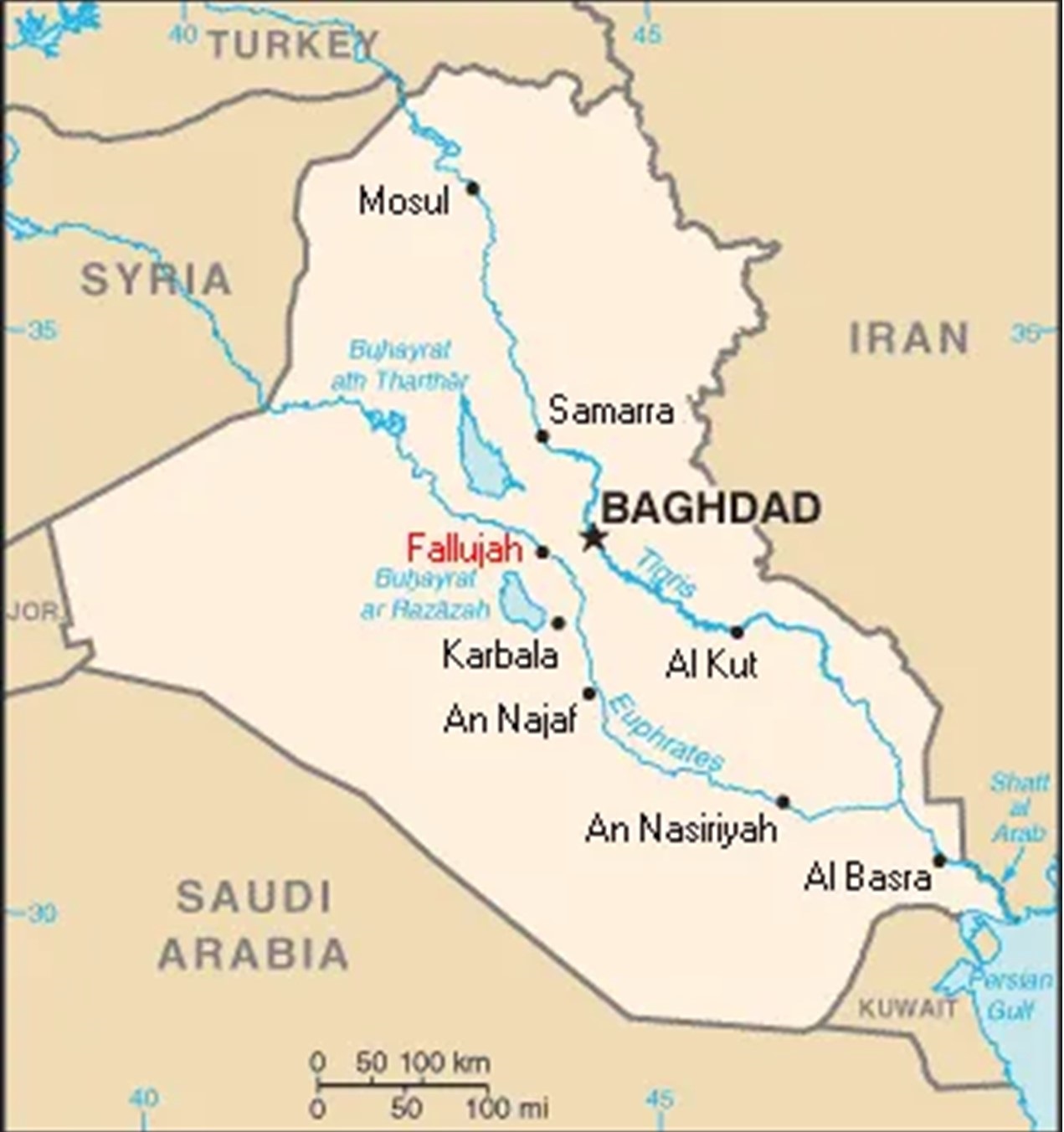
43 miles west of Baghdad, lies the city of Fallujah in the al-Anbar province of Iraq. It is a densely populated, industrial city with a long history as a way station & trading post along the ancient silk road that connected Baghdad to major trading centers to the west such as Cairo & Constantinople. In 2004, Fallujah had an estimated quarter million population. The city was just under a 2-mile square & consisted of over 2,000 city blocks laid out in a haphazard grid pattern with wide boulevards, narrow streets, & alleyways mostly filled with heaps of garbage & immobile automobiles. The city had over 50 thousand buildings & structures, most of which were two-story concrete houses, but there were also some spacious homes, with courtyard walls, some half-completed dwellings, & many old inactive factories in the industrial areas. The city was bordered on three sides by prominent natural & man-made terrain features with the Euphrates River on the west, a rail network on the north, & a major freeway, Highway 11, running the length of its eastern edge. The United States did not find administering the city easy. It became more of a problem on February 12, 2004 when Fallujah insurgents attacked a convoy carrying 82nd Airborne Division (AbnDiv) Commanding General (CG) MajGen Charles Swannack, USA & General John Abizaid, USA, CENTCOM Commander, firing on the vehicles from nearby rooftops with rocket propelled grenades (RPGs) & small arms.
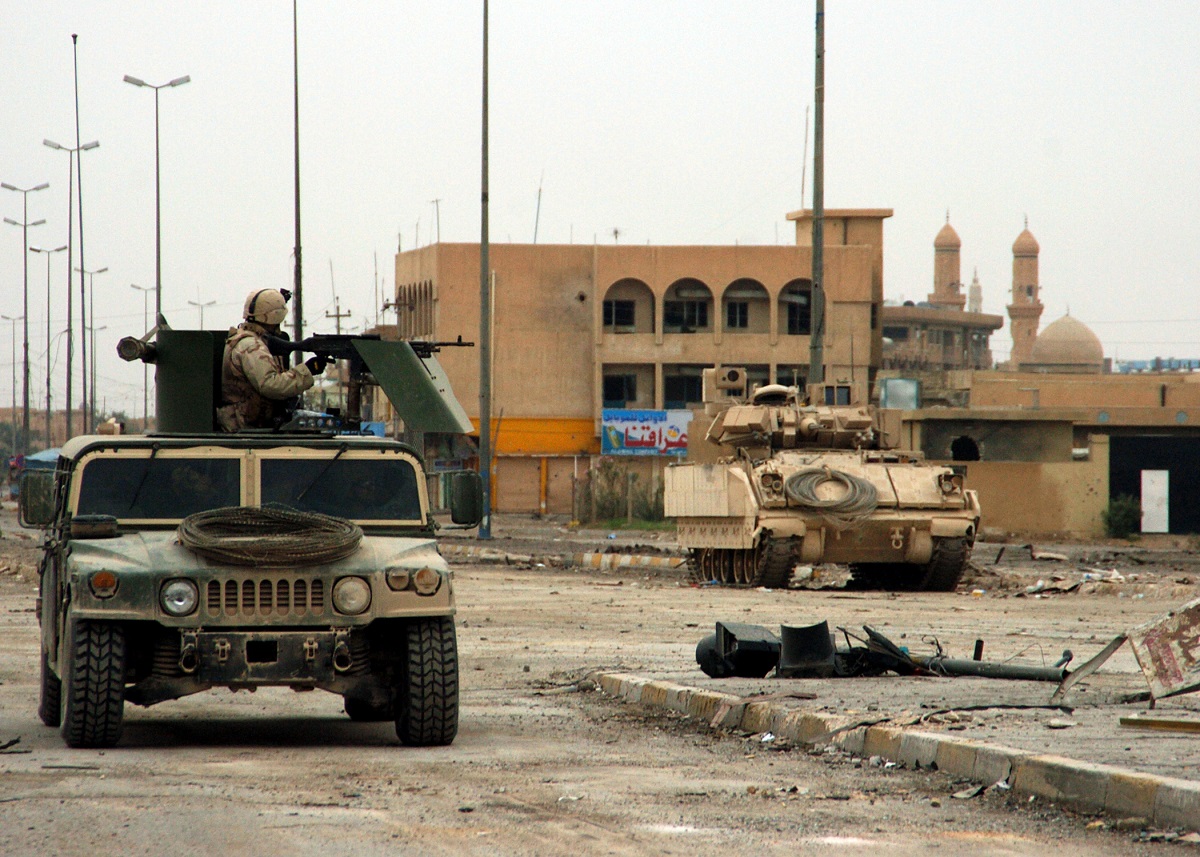
Several US Army units had patrolled Fallujah once the coalition invasion had captured Iraq in March 2003, including small forces from the 82nd AbnDiv. These under-manned units, in relation to the size of the city for which they had been given responsibility, reportedly relied on a “carrot & stick” approach. The former being a number of lucrative contracts for reconstruction projects & civic action initiatives & the latter being a number of aggressive raids against important insurgent leaders & quashing anti-government protests. Although there were varying degrees of success with this approach there were never enough American forces committed to calm a city-wide insurgency. It did not help that the reformed Iraqi police forces were unwilling to physically enter the city & engage the Saddam loyalist troops bolstered by Muslim terrorist from other nations. There were also a series of clashes between armed civilians in Fallujah & American soldiers that led to increasingly volatile situations. For example, on 28 April 2003, 82nd AbnDiv paratroopers in the city were besieged by a mob that they engaged killing 17 & wounding over 70 protestors to escape. The action inflamed anti-American attitudes and set the tone for operations in the city over the course of the following year. Fallujah rapidly fell under the influence of insurgent factions & violence against the paratroopers & cavalry troopers who replaced them was on the rise.
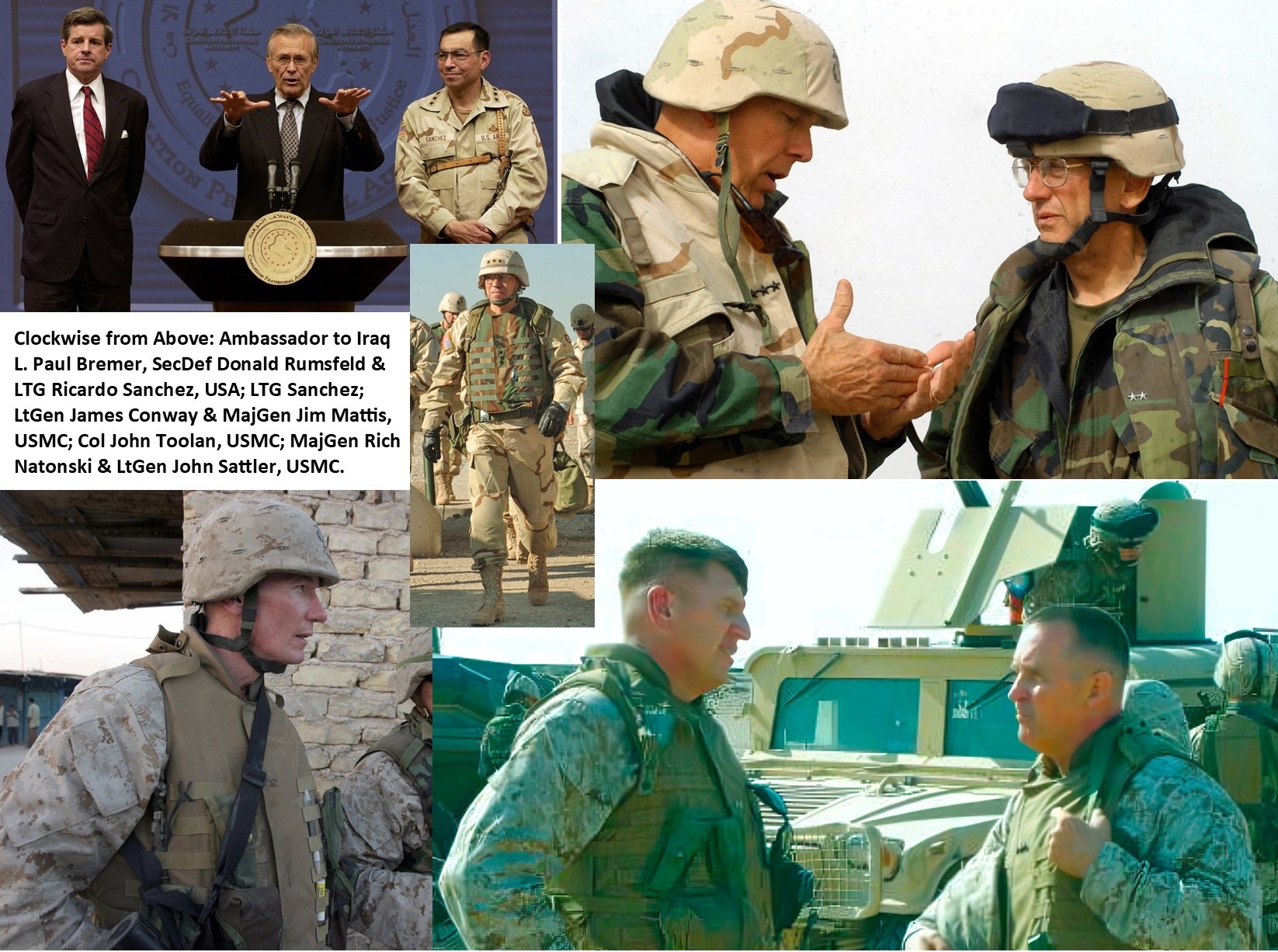
In March 2004, 82nd AD CG Swannack transferred authority of the Al-Anbar province to LtGen James Conway the CG of I Marine Expeditionary Force (MEF.) The 1st Battalion, 505th Parachute Infantry Regiment turned over responsibility for Fallujah to the 1st Marine Division (MarDiv) on March 24, 2004. To prepare for its deployment to al-Anbar, I MEF’s Ground Combat Element commander, MajGen James “Mad Dog/Chaos” Mattis, set about indoctrinating his 1st MarDiv in the practices & principles of counterinsurgency. The Marines would approach the security problem in the cities differently than the 82 AbnDiv had. They would patrol through the city streets, develop combined units integrating Marines & Iraqi soldiers, hoping to cast a different image to the Iraqis more “carrot” than the unnecessarily heavy-handed “stick” the Army had employed. Mattis believed strengthening relations between the Americans & Iraqis leaders & estrange the insurgent forces from the general population using the motto, “no better friend, no worse enemy.” The Marines would focus on defeating the insurgency, not just insurgents. The Mattis approach, was supported by his superior, LtGen Conway (a future Commandant 2006-10.) By the end of March 2004, I MEF had assumed full responsibility for security in al-Anbar from the 82d AbnDiv. Mattis went to Iraqi military leaders in each area his troops were deployed & told them his doctrine to gain their attention: “I come in peace; I didn’t bring artillery. But I’m pleading with you, with tears in my eyes: If you fuck with me, I’ll kill you all!”
Colonel “Big John” Toolan, USMC, Commander of the 1st Marine Regiment recalled: “Transparency was the name of the game. We knew we didn’t know who to trust. So, go in with the mentality that we care, and we’ll work with you.” In a tactic that reached back to the Marine “Combined Action Platoon” anti-insurgency program decades earlier in Vietnam, the plan called for small units of Marines to live among the people in many Sunni towns & villages to facilitate training of the Iraqi police & civil defense forces.

Above: The infamous “Blackwater” Bridge
The Marines never got a real chance to work their counterinsurgency plans in Fallujah as on 31 March 2004, four contractors from the Blackwater private security firm entered the city of Fallujah in two sport utility vehicles to provide security for a Eurest Support Services convoy (a subcontractor of Halliburton KBR.) They did not inform the local Marine headquarters to gain permission (despite injunctions on unauthorized travel in the city) & thus the Marines were unprepared to protect the contractors when their vehicles were ambushed & destroyed. The contractors were all killed by machine gun fire & hand-grenades, before their bodies were burned & hung from the King Faisal Bridge which spanned the Euphrates River in Fallujah’s western section. Footage of the burnt, mutilated bodies of Americans hanging in front of cheering local crowds were broadcast by the terrorist supporting cable news network Al-Jazeera.
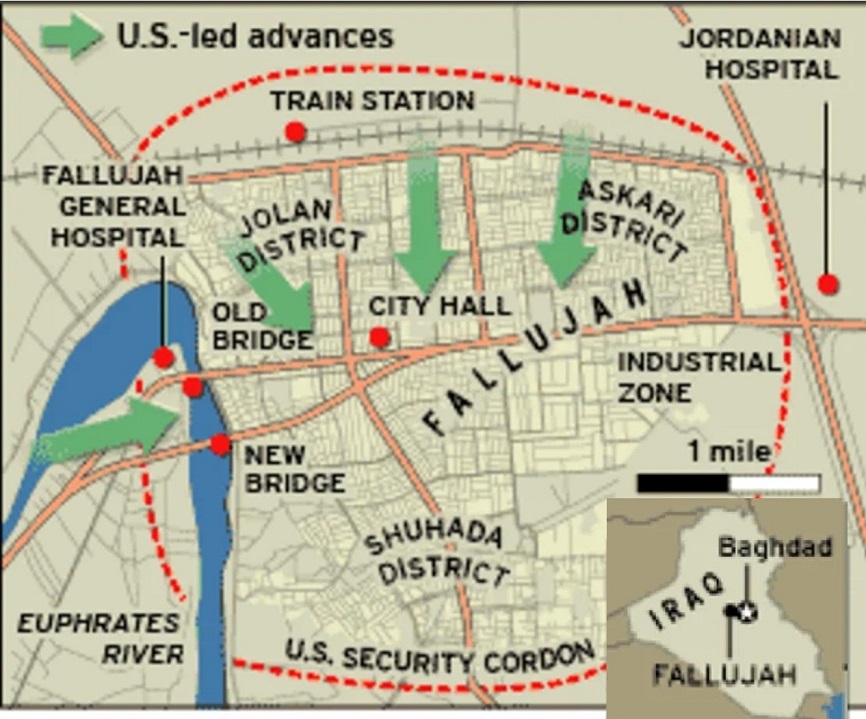
On 3 April 2004, under immense political pressure from the White House through Donald Rumsfeld the Secretary of Defense, LtGen Ricardo Sanchez, USA, Commander of Coalition Ground Forces ordered I MEF to conduct an offensive operation that was codenamed Operation Vigilant Resolve (First Battle of Fallujah) to flush out the Islamic terrorists within the city. Both Generals Conway & Mattis vigorously protested the misguided order, arguing that a large-scale operation without extensive proper planning & in-depth intelligence would be a punitive aim, endanger civilians, & ultimately fail to achieve the primary objective of locating the individuals responsible for the contractors’ murders. Their protests were ignored & I MEF launched an assault into the city on 4 April. Over the course of six days, three Marine battalions from Regimental Combat Team (RCT) 1 commanded by Col Toolan established a cordon around the city & then began a slow and methodical advance into the city. The fighting against the terrorists was fierce as the al-Qaeda forces utilized every structure in the city for cover, including mosques & schools, as they fought the advancing Marines.
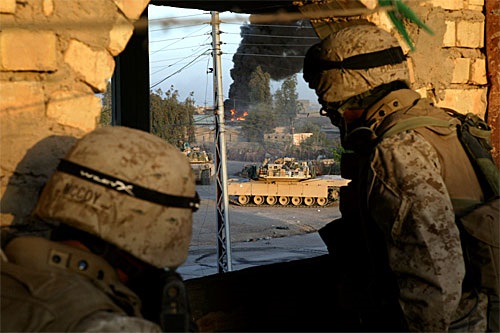
Above: Marines of 1st Marine Regiment in Fallujah. Infantrymen from 1st Platoon, Company E, 2nd Battalion, 1st Marine Regiment, 1st Marine Division, look on from a rooftop as M-1A1 tanks from 1st Tank Battalion fire on buildings where enemy snipers took positions. The company entered Fallujah, Iraq, on April 6, 2004.
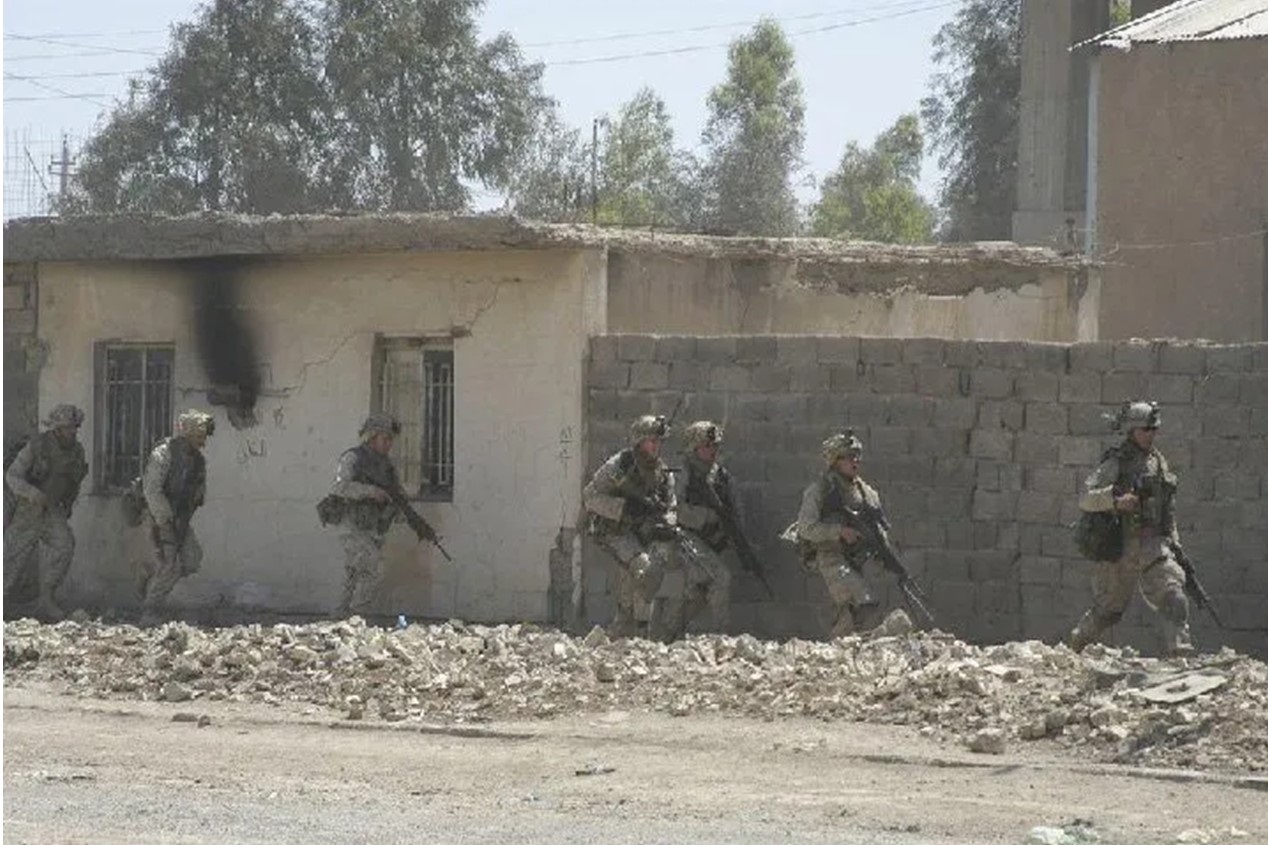
After six hard fought days, L. Paul Bremer, US Administrator of the Coalition Provisional Authority (CPA) (created following the 2003 invasion of Iraq), unilaterally announced a ceasefire, stating that he wanted to facilitate negotiations between the Iraqi Governing Council, insurgents, & city spokespersons, plus allow government supplies to be delivered to Fallujah residents. It was estimated that 600 Iraqis had been killed, at least half were non-combatant residents. Although hundreds of insurgents had been killed in the assault, the city remained firmly under their control. The Marines had by then only managed to gain a foothold in the city’s southern industrial district. The end of major operations for the time being led to negotiations between various Iraqi elements & the Coalition forces, punctuated by occasional firefights. The incidents began & the largest civilian outcry was when Marines were ambushed by insurgents firing from within a mosque & an U.S. airstrike dropped it to rubble.
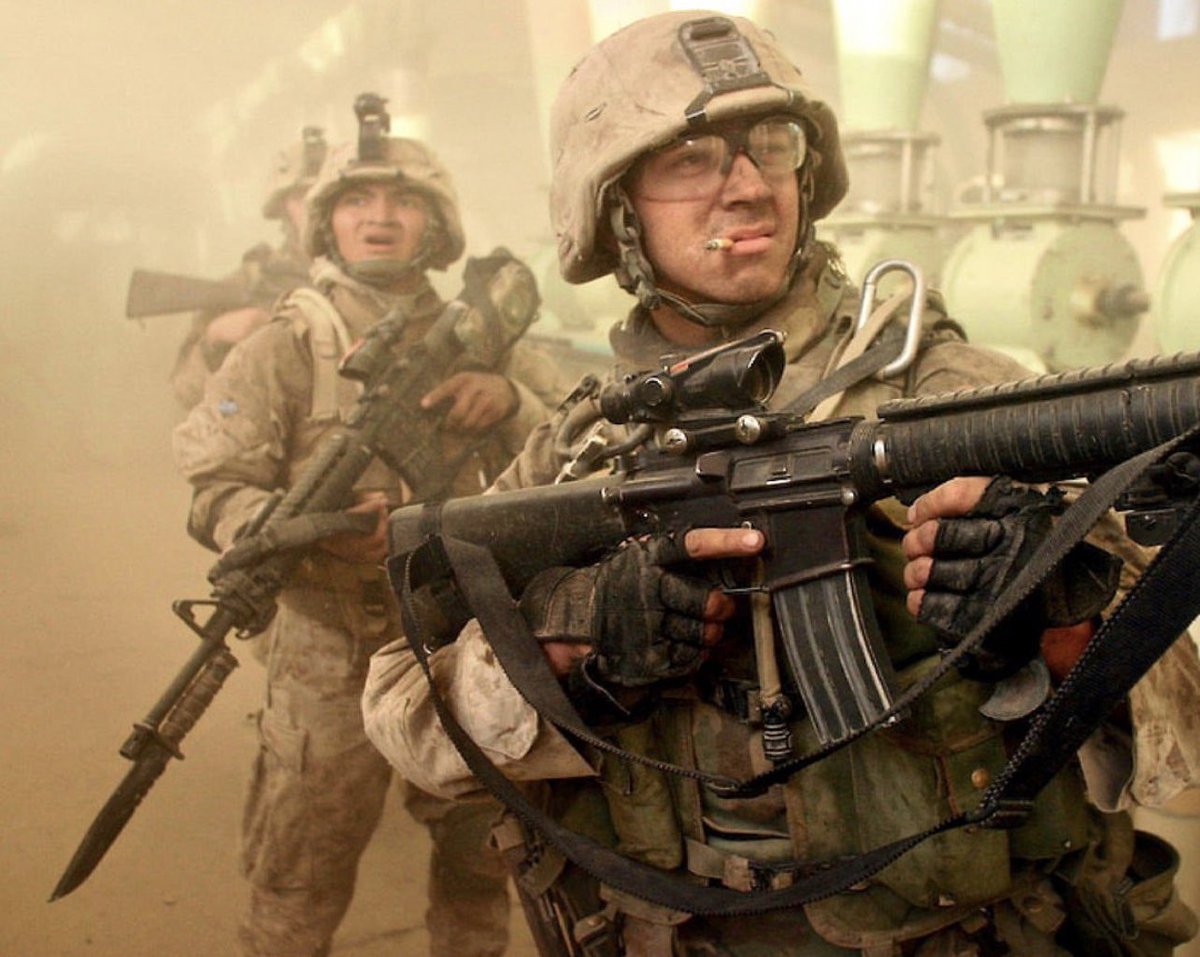
Retired LtGen “Big John” Toolan, the commander of RCT 1, told “The War Horse” years after he led his Marines into the first major instance of close-quarters battle (CQB) by the U.S. military since the Tet Offensive in Vietnam, he still has questions about the decisions made far above his head. “It didn’t turn out very well,” he said. Toolan launched Operation Vigilant Resolve with a plan for one battalion of several hundred Marines to take control of the southern half of Fallujah, while another battalion captured the northern half of the city. Toolan, for his part, by April 8 believed that his Marines were on the cusp of taking back the whole of Fallujah however the next day, less than a week after the fighting had begun, the order for the unilateral ceasefire came through. The origins of the order remain shrouded in ambiguity, with some speculating that it came directly from the White House. “We wanted it so bad, that we got it bad,” Toolan said of a resolution to the conflict. “You can’t start a fight and then end the fight before it’s over. No one understood the impact that had on morale.” All summer long, General Toolan said, foreign fighters poured into the city, itching for a fight, making it clear to both sides that another battle, a bigger, bloodier battle, was imminent. Six months after the unfinished first one, it arrived.
To police Fallujah in May, after DOD’s ill-conceived Op Vigilant Resolve, General Conway gambled on an all-Iraqi force, armed & trained by the CIA known as the Fallujah Brigade. This force, Conway hoped, would be able to better stabilize the city & help reduce the impression that just the US was interested in clearing insurgent forces from the city. The brigade ultimately failed, melting away with their weapons, many siding with the insurgency. The rebellion taking place in Iraq was a multifaceted movement assembled from former-Baathists, Sunni nationalists, Saddam loyalist military veterans, & international Islamist terrorists organizations affiliated with al-Qaeda with a fanatical desire for a new fundamentalist state in Iraq.
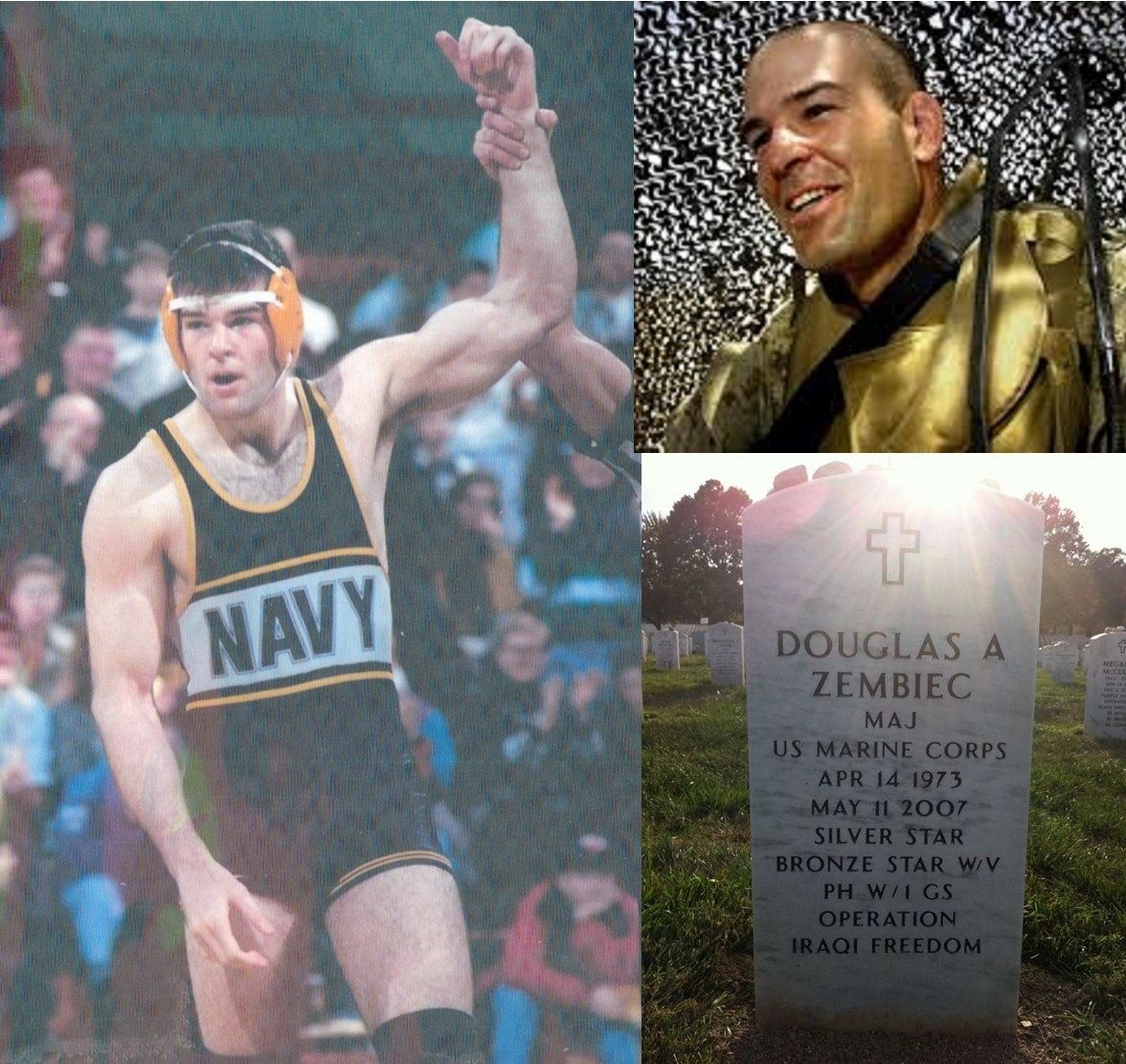
The most memorable leadership story from the Op Vigilant Resolve was the Company Commander nicknamed the "Lion of Fallujah." Capt Douglas Zembiec was a Naval Academy Class of 1995 graduate who went 95-21-1 in the Eastern Intercollegiate Wrestling Association. He won two league titles for the Academy & was a NCAA All-American at 177 pounds in his final season. He was a rifle company commander of Echo, 2nd Battalion, 1st Marine Regiment, & led 168 Marines & Navy Corpsmen for the first conventional ground assault into Fallujah. His heroism was well documented when he ran out from cover despite heavy machine gun & RPG fire, jumped on a supporting M1A1 tank & directed its fire on insurgent positions, then returned to cover unscathed. A fellow officer stated "The jaws of every Marine there had dropped open in awe. I am a God-fearing man, but he just sort of walked on water that day." He earned the Bronze Star with Combat Distinguishing Device & the Purple Heart. as a result of his heroic actions commanding Echo Company while extolling the heroism of his Marines, saying "they fought like lions." As a Major on his second tour, his Iraqi unit was ambushed & his heroic efforts saved his men but he was felled by an insurgent round. He is remembered annually by both the Douglas A. Zembiec Award for outstanding leadership in Special Operations & the Major Doug Zembiec & Major Ray Mendoza Memorial Scholarship.
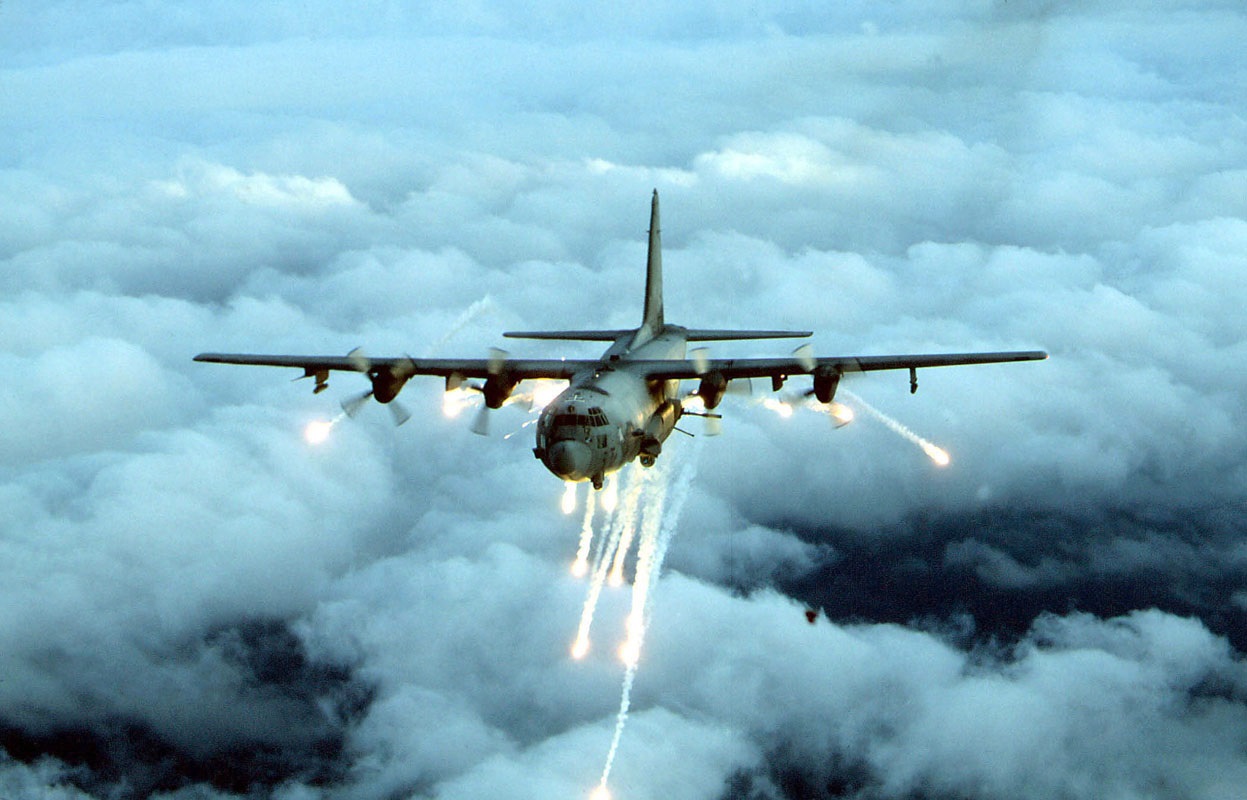
After the First Battle of Fallujah on 27 April, Marines repulsed a sustained enemy attack on Echo Company 2/1’s defensive positions. Capt Zembiec, said his outnumbered Marines "fought like lions" to fend off that attack. In support, a USAF AC-130H Spectre gunship fired on suspected insurgent positions & attacking weapons storage sites used by anti-coalition forces. News reports said the coalition launched the CAS on targets in Fallujah at about 11 P.M. Iraq time after the terrorist forces fired on Marine defensive positions. A U.S. pool reporter said the gunship circled twice, launching as many as 25 rounds on each target. Televised video showed secondary explosions from the ground following the attack.
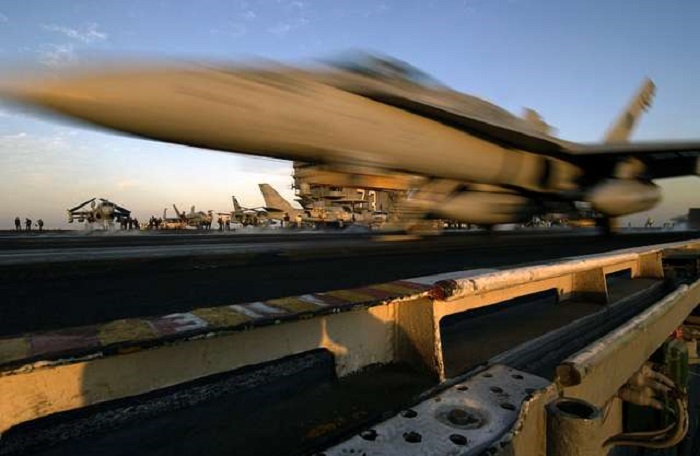
After the Marines had to call in combat air support (CAS), so in response on the following day, the aircraft carrier USS George Washington (CVN 73) launched its Carrier Air Wing Seven (CAW-7) attack squadrons VFA-11, 131, 136, & 143 to fly CAS sorties against insurgents in Fallujah. During this operational surge of naval aircraft from the CAW dropped 13 of the highly effective & accurate GBU-12 Paveway II laser-guided 500-pound bombs on insurgent positions providing effective CAS for the 1st MEF.

After the First Battle of Fallujah, the insurgency also gained prestige with an al-Qaeda operative Abu Musab al-Zarqawi emerging as a charismatic & influential terrorist leader. Zarqawi a high school dropout, gained a reputation as a accomplished pimp, bootlegger and thug in Jordan. He was thrown in prison in 1993 for possessing illegal weapons. Prison life took Zarqawi to another level of flesh hustling as he learned the Quran and used his charisma to recruit prisoners for Islamic jihad. Unfortunately, the insurgency was united largely only by the shared desire of its members to end the U.S. occupation of the country. Many nationalists & militias aligned with the tribes & found themselves forced into an uneasy alliance with the foreign Islamist terrorists from 17 different countries led by al-Zarqawi. Insurgent terrorism inside Fallujah peaked during the fall after al-Zarqawi ordered the beheading of three British & a Japanese contractor & making video propaganda for the al-Jazeera to broadcast worldwide.
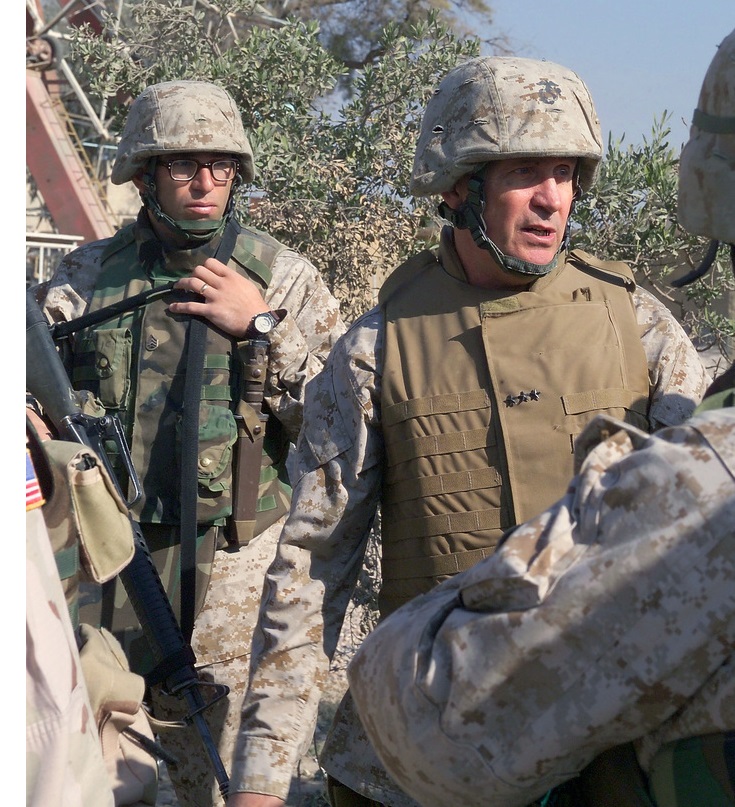
Retribution fell again to I MEF, now commanded by LtGen John Sattler, USMC, who relieved LtGen Conway in September. Sattler, a 1971 U.S. Naval Academy graduate had a distinguished career before assuming command of I MEF including commanding the 2nd Marine Regiment & as assistant division commander of the 2nd Marine Division. The Marines had time for covert operations to attain actionable intelligence of the area of operations as unmanned aerial vehicles monitored the city 24-hours-a-day, often catching guerrillas as they reinforced fighting positions, placed mines & IEDs, or loaded weapons into cars, buildings, & mosques for the impending battle. By the end of October, the Marines had convinced the majority of Fallujah’s population to depart leaving fewer than 500 civilians in the city. Coalition intelligence also concluded that 3,000 to 4,500 insurgents remained & 33 of the 72 mosques were being used as insurgent defensive positions & staging areas for weapons & ammunition depots.
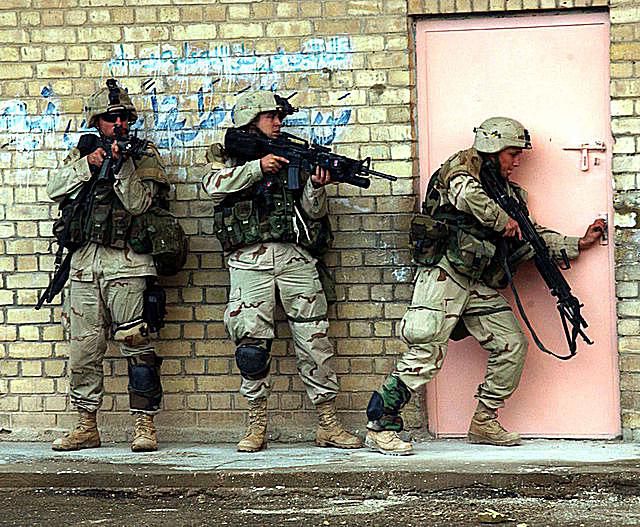
Neither side was totally ready for fighting in a cityscape in the short fused First Battle of Fallujah but the Marine Corps prepared all summer for its largest urban warfare since the Battle of Hue City, a month-long struggle to reclaim the old French Imperial Capital during 1968’s Tet Offensive & one of the bloodiest engagements of the Vietnam War. Unlike other environments, urban terrain contains unique characteristics that are conducive to very strong & lethal defense operations. The density, hardened construction, & complexity of man-made physical terrain in urban areas allows defenders to strengthen their defense plan. These plans seek to break apart attacking formations, separate mounted from dismounted forces, limit the attacker’s ability to maneuver & channel them into kill zones. The defenders want to degrade the attackers’ military technologies like communication, intelligence, surveillance, & reconnaissance & CAS strike capabilities, maximize surprise, & either defeat the attackers in detail or buy time for other defensive operations to be initiated.
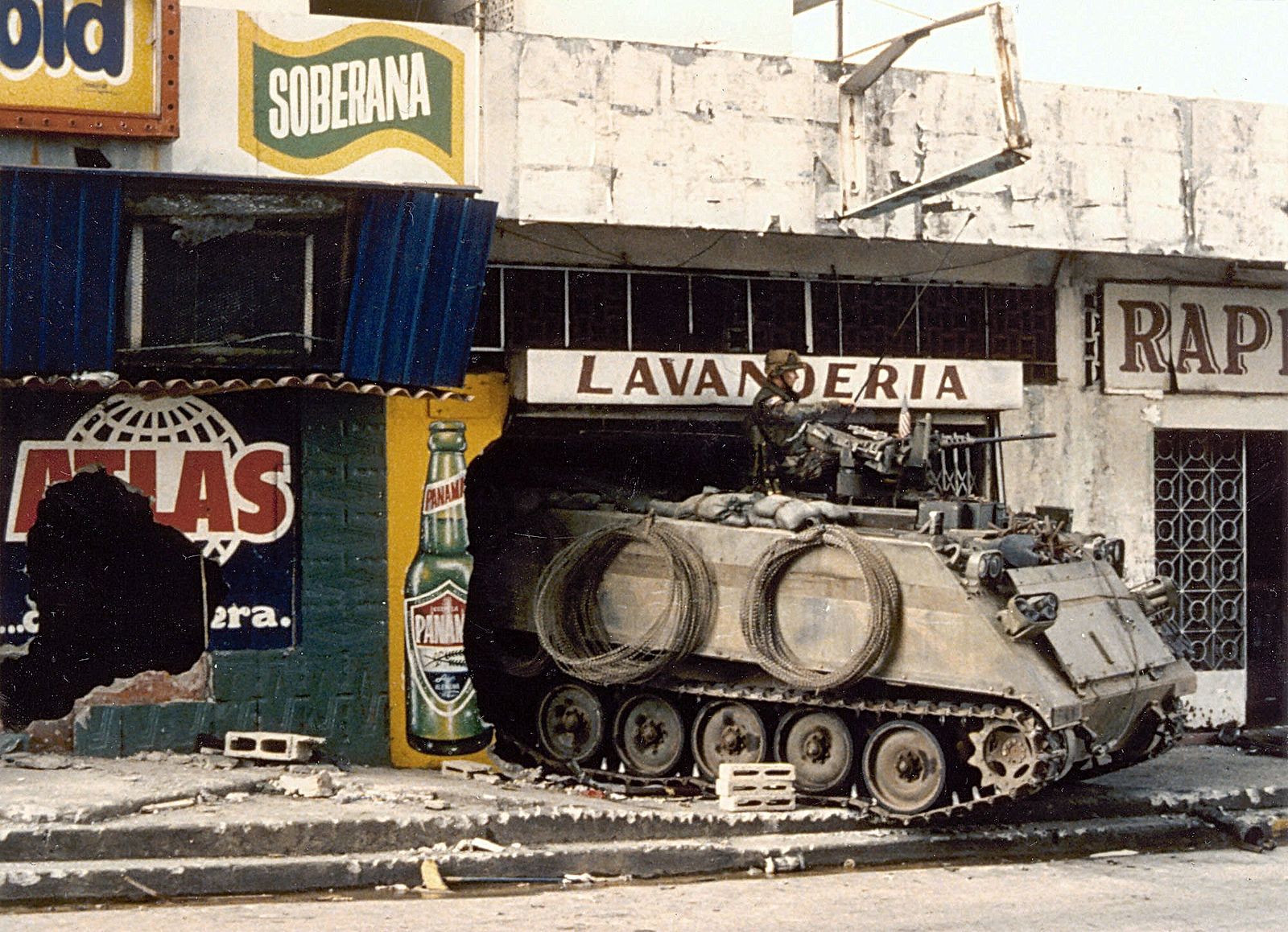
Above: M-113 in Panama City during Operation Just Cause
The Marine Corps began studying Military Operations in Urban Terrain (MOUT) in the early 1980s leaning on the lessons from Hue City & the British military operations in Northern Ireland. The Marines & Army got some training during Operation Just Cause in 1989 as the Battle for Panama had MOUT lessons & the Army got a more costly lesson during the Battle of Mogadishu commonly called the Black Hawk Down Incident in Somalia that had the most US Servicemen KIA since 1968’s Battle of Hue. I was one of the three Captains from The Basic School Staff that drove down from Quantico, VA to Fort Bragg, NC in early 1985 to study the Army’s Special Forces kill/shoot houses. These facilities are live ammunition small arms shooting ranges used to train military personnel for close-quarters battle (CQB) engagements in urban combat environments. The Ft. Bragg kill house was designed to mimic residential & industrial spaces & were used to acquaint small units with techniques to infiltrate urban structures & train to overwhelm the hostile target(s) in the quickest & most lethal manner.
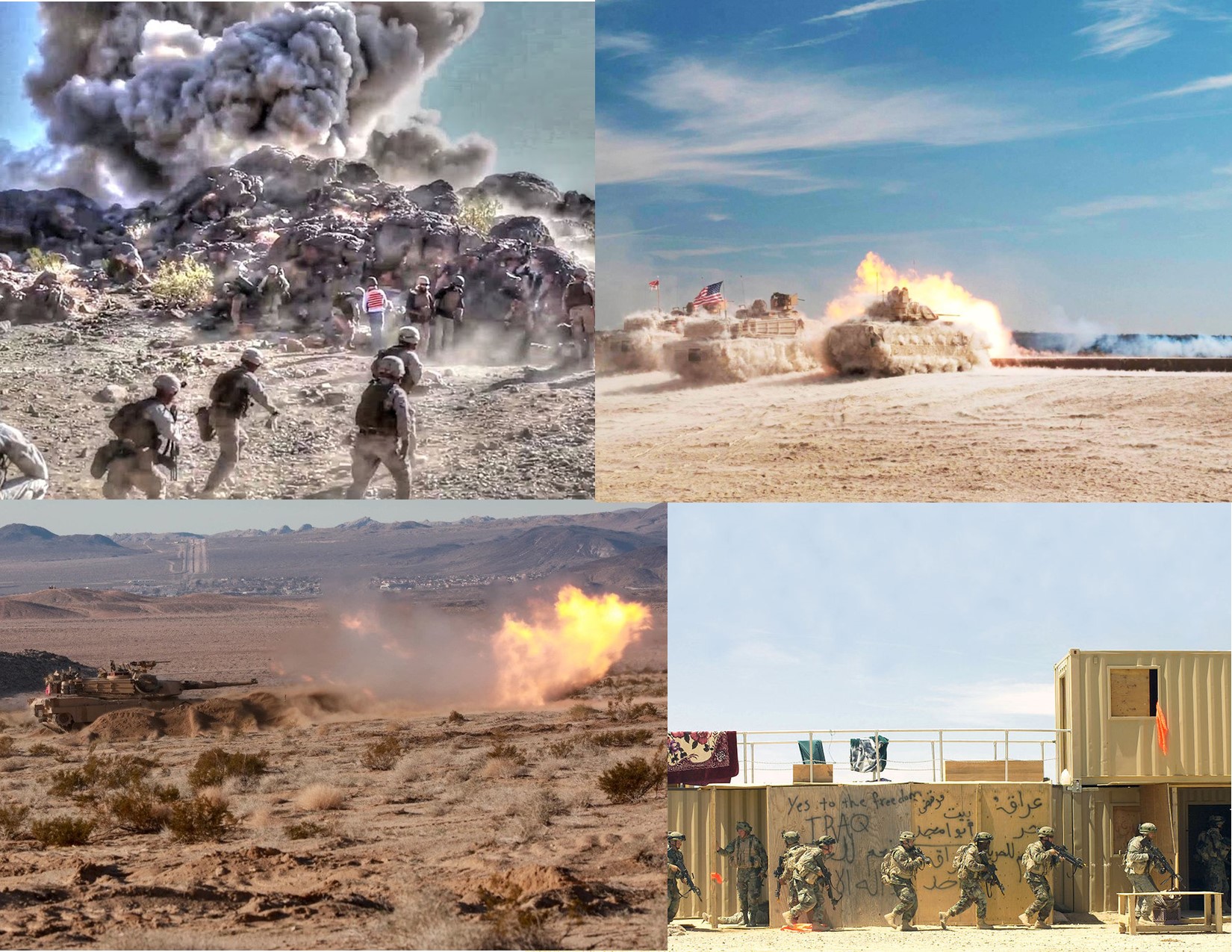
Our study urged the immediate construction of a kill/shoot house to train Marine Officers in CQB. There is inherent danger in live fire training but the Marine Corps knew the importance of live-fire by creating Combined Arms Exercises (CAX) at the Marine Corps Air Ground Combat Center Twentynine Palms, CA & the Army conducted large scale exercises at Fort Hood, TX & The National Training Center at Fort Irwin, CA.
By the end of summer 2004, US intelligence had identified more than 300 well-constructed & hardened defensive positions, a large number of roadblocks, heavy equipment constructed berms, indirect fire positions, sniper & fighting positions, plus multiple daisy-chained IEDs along the city streets. The placement of these defensive positions indicated that I MEF’s preliminary attacks & psychological operations had convinced the insurgents that the main effort would come from the area around the cloverleaf interchange between Highway 10 & Highway 1 to Fallujah’s east, & from the southeast. Marines’ intelligence had uncovered a well-planned “three ring defense” inside the city as secondary positions along Highway 10 & strongholds in the Jolan District, the Sook District (south of the Jolan), and the Muallimeen District (east of the Sook) showed an insurgent willingness to fight in depth & not flee the city.
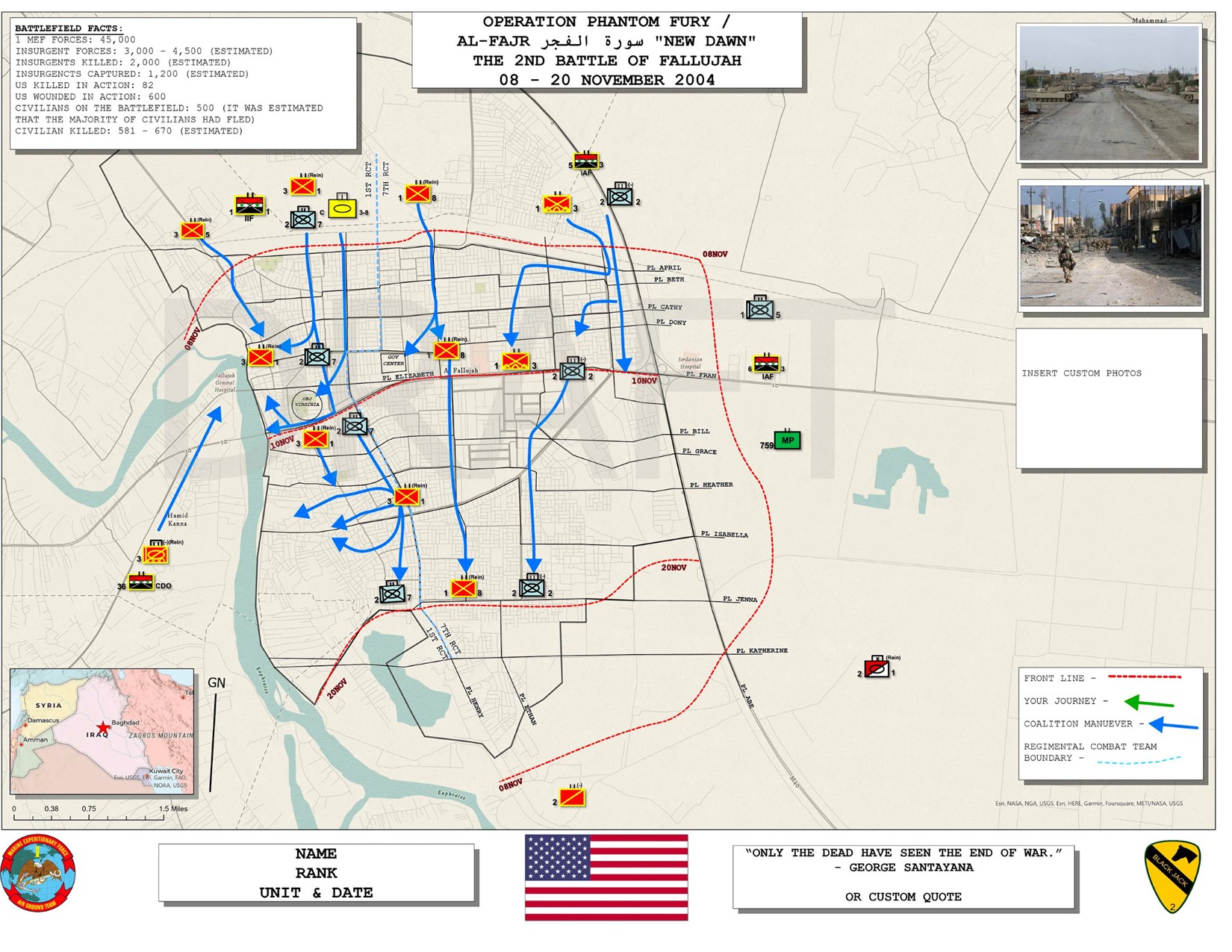
MajGen Richard Natonski, the new Commanding General of the 1st MarDiv, knew for the Second Battle of Fallujah, Operation Phantom Fury/Al-Fajr that he needed enough units to not only clear the city, but seal it & prevent insurgents from fleeing in the face of the Coalition advance. To address this need, the commander of the Multi-National Corps Iraq (the command responsible for day-to-day operations throughout Iraq), LtGen Thomas Metz III, USA, transferred two Army armored battalions & an Army armored brigade to reinforce the 1st MarDiv. The division’s northern assault force would be divided into two regimental combat teams (RCT.) RCT 1 (formed around the 1st Marines) that would include the 3rd Battalion, 5th Marines, 3rd Battalion, 1st Marines, & the U.S. Army’s 2nd Battalion, 7th Cavalry. The second was RCT 7 (formed around the 7th Marines) including 1st Battalion, 8th Marines, 1st Battalion, 3nd Marines, & U.S. Army’s 2nd Battalion, 2nd Infantry. The 2nd Brigade Combat Team (formed around 2nd Brigade, 1st Cavalry Division), would serve as the principal blocking force stationed to Fallujah’s south. General Natonski also incorporated elements of the 11th Marine Expeditionary Unit (MEU) & the 24th MEU.
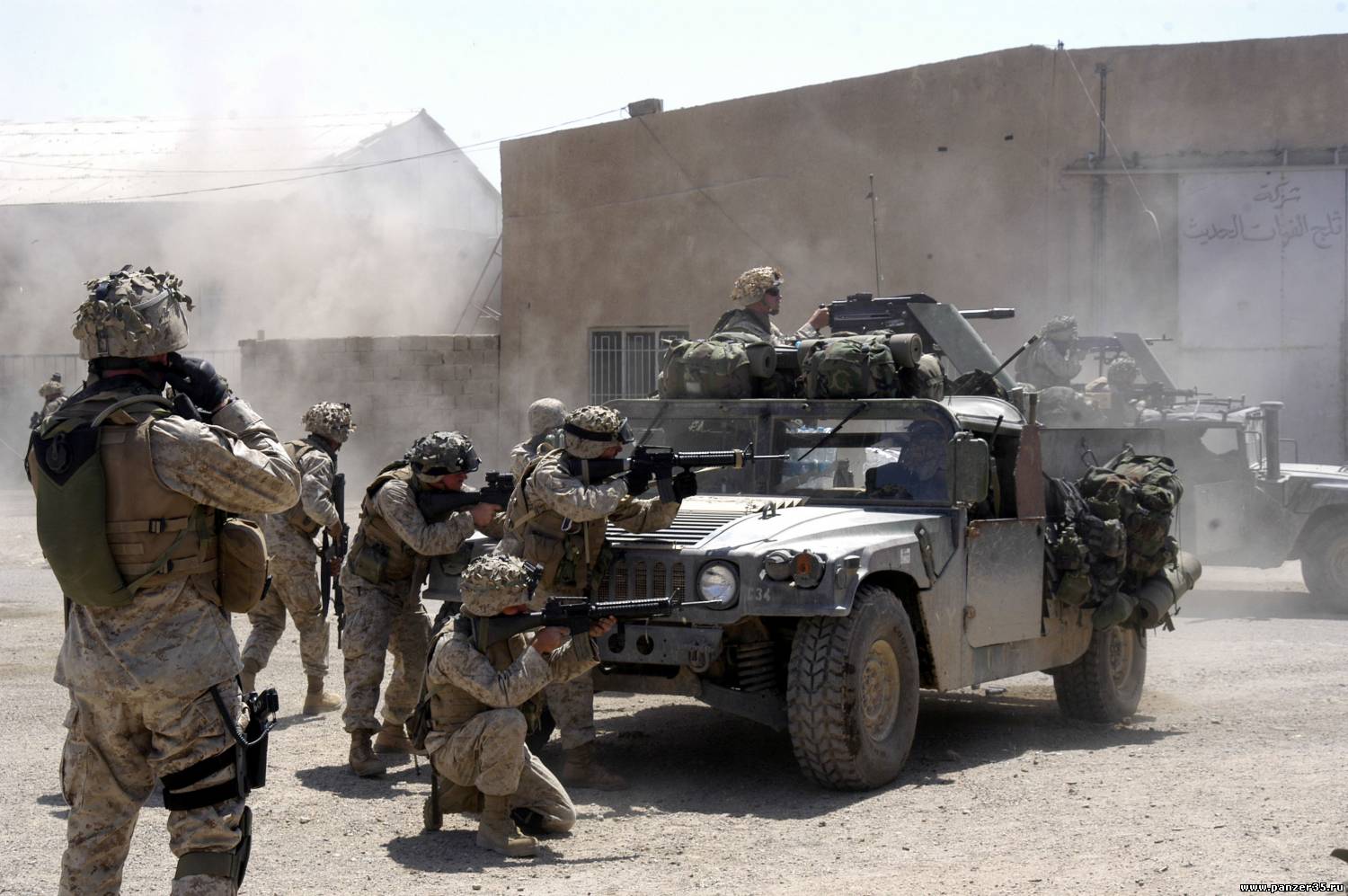
Above: U.S. Marines with Company A, 1st Battalion, 5th Marine Regiment, Marine Captain Philip Treglia calls in a danger close airstrike while his Marines fire against terrorists operating in Fallujah, Iraq.
American Veterans Center Sgt Robert Day: https://www.youtube.com/watch?v=IYV00-iScoo
Natonski’s 1st Marine Division serve as the principal ground headquarters for Operation Phantom Fury/ Al-Fajr. Essential to the battle was the inclusion of Iraqi security forces. These forces had to be brought into Fallujah from outside al-Anbar Province because Anbari soldiers would not fight their own tribesmen or other regional tribes. All in all, the attack force included nine U.S. Army and Marine battalions and six Iraqi battalions (12,000 Marines, soldiers, sailors, airmen, and Iraqi security forces). For the battle, I Marine Expeditionary Force (I MEF) would grow from 32,000 to 45,000 personnel. I MEF had supporting arms with CAS that at different times included F-16 fighter jets, F/A-18 fighter/bombers, AV-8B Harriers, AC-130H Spectre fixed-wing gunships, & AH-1W Cobra helicopter gunships in addition to fire support from 1st Battalion, 11th Marines with 155mm artillery batteries.
Phantom Fury brought together U.S. Marine Corps, Navy, Army, British and Iraqi forces, all structured around two Marine regimental combat teams. Marines noticed the insurgents no longer attacked in small groups of 6 to 12 people like they had in April, but were now attempting tactics using larger formations. Marines also witnessed that a precision air strike on insurgent fortifications set off not only a series of secondary in the targeted building but also explosions from daisy-chained improvised explosive device (IEDs) along a primary road as well. The primary operation began on 4 November & continued to 16 November.
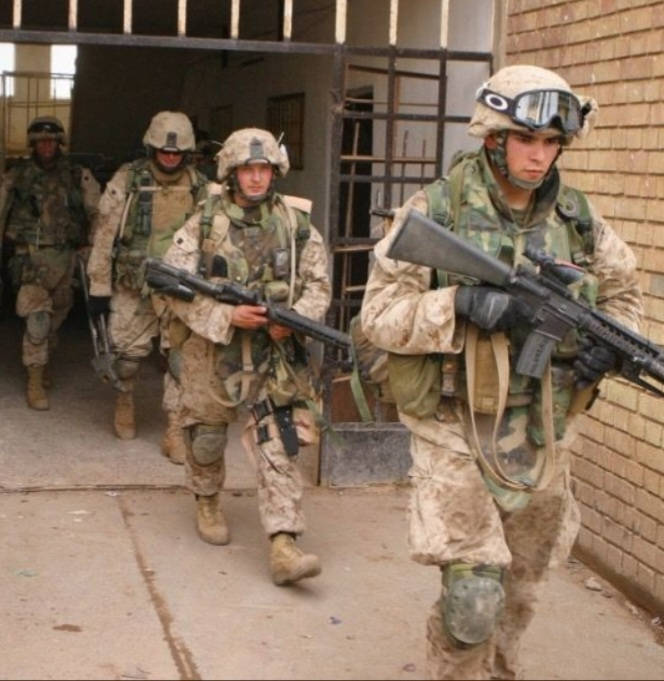
The Marines of LtCol Willy Buhl’s 3rd Bn, 1st Marines, fell under RCT 1, and were tasked with clearing the west side of the city. “Unfortunately, we had some of the more difficult people to kill or capture,” explained Buhl. “Because certainly down in the south of the city, a place we called ‘Queens,’ that's where most of the outsiders came to occupy the city & fight us.” The main objective of Phantom Fury was to clear the city, return it to the Iraqi government, and to kill or capture any insurgents who offered resistance to the coalition forces. Buhl said intelligence at the time indicated insurgents from 16 different countries participated in fighting against the U.S.-led coalition. “We watched the insurgents in the city fortify it, & they were brazen about it,” said Buhl. “They brought engineering equipment out & cranes & jersey barriers. We watched them build, you know, build their fortress there, day after day, and knowing that at some point we were going to have to assault it.”
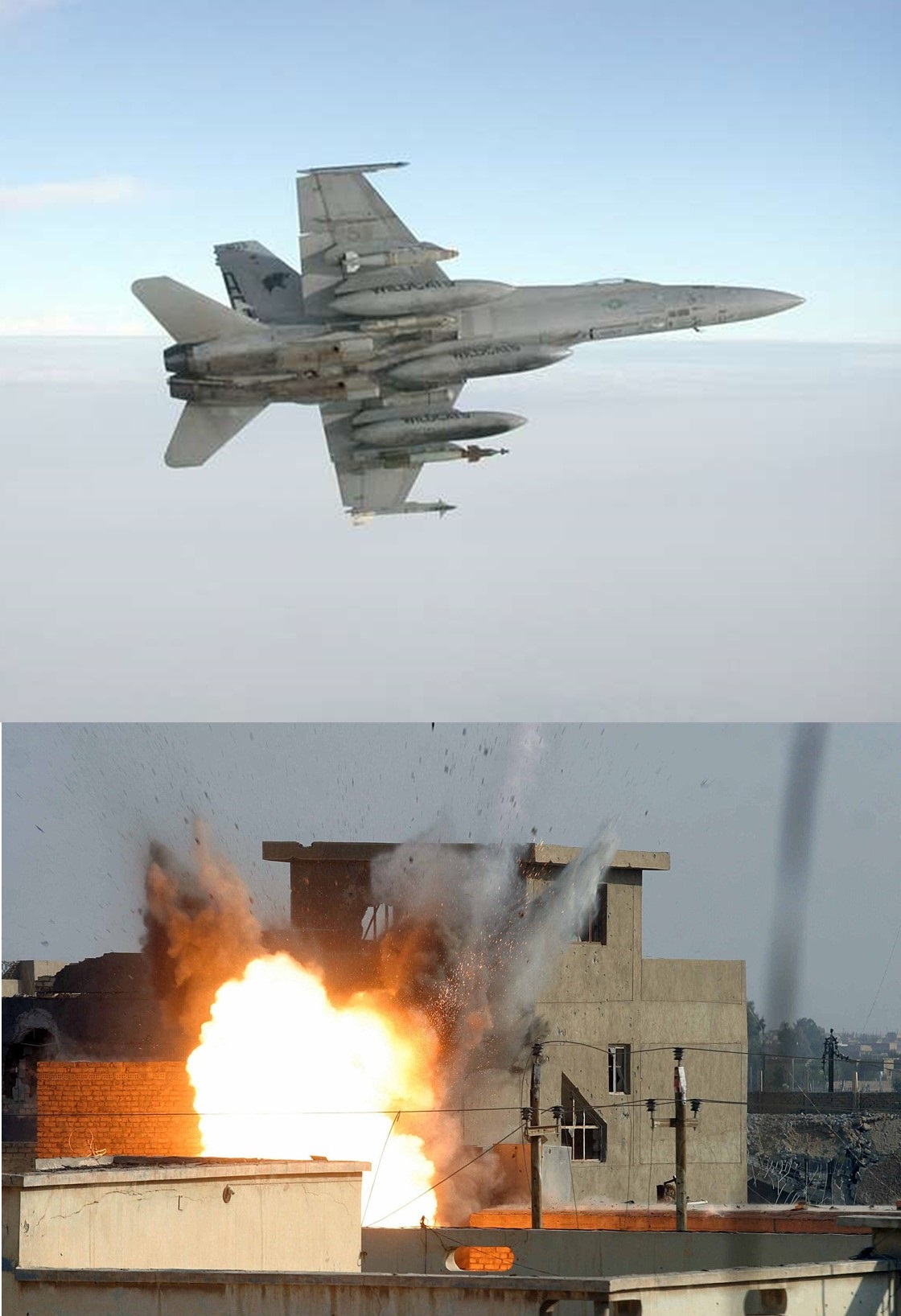
On the Marine Corps Birthday 2004, A precision air strike takes out an identified insurgent stronghold as 3/1, 1st MarDiv moves forward on Security and Stabilization Operations (SASO) through the city of Fallujah, Iraq, during Operation Phantom Fury/Al Fajr (New Dawn.)
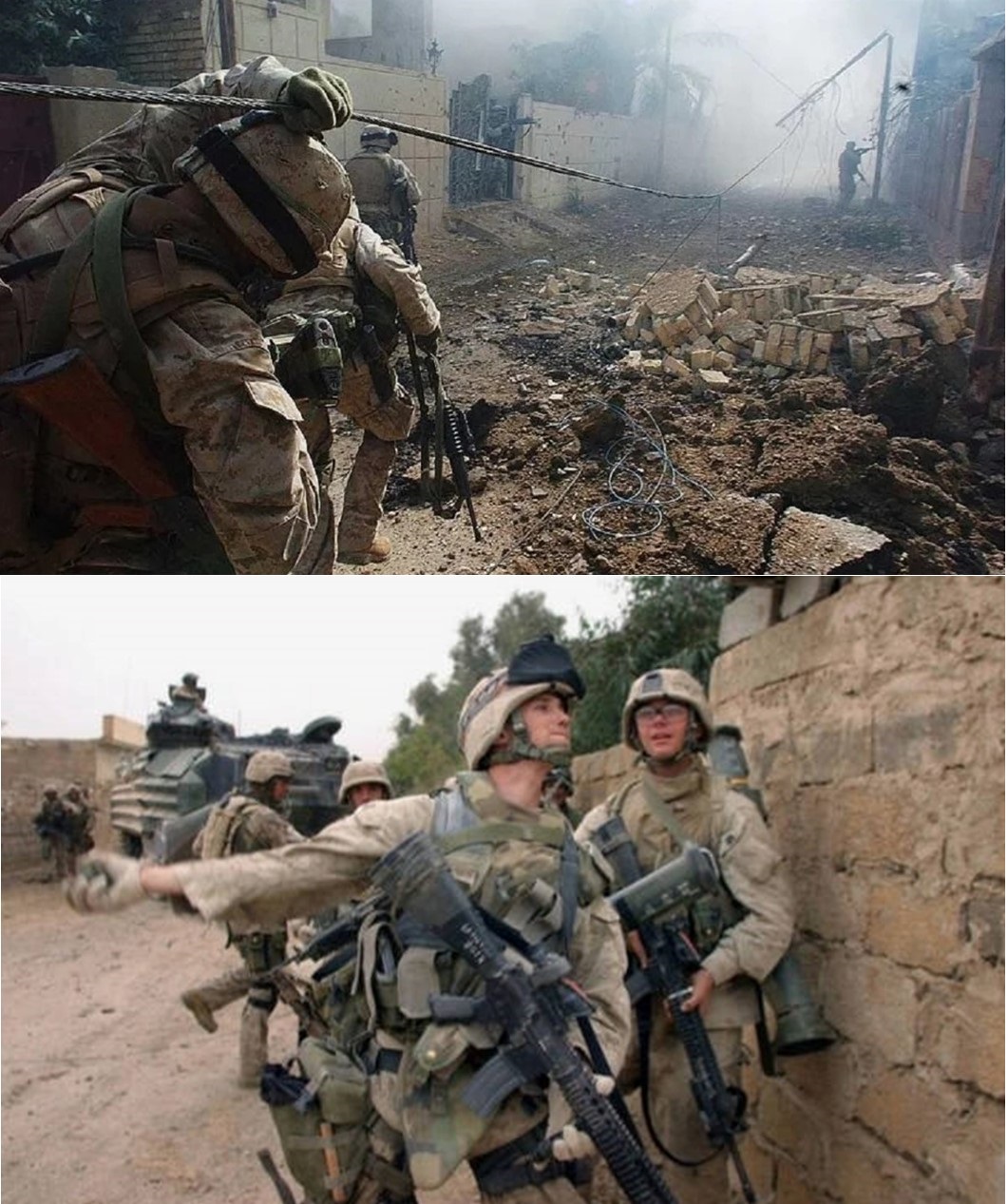
For both Marines & soldiers, the house-to-house fighting was intense & nerve-wracking work. “The fighting has been incredibly close inside the city,” wrote Marine LtCol Dave Bellon, RCT 1 Intelligence Officer, in an email message to his father on 19 Nov. “The enemy is willing to die & is literally waiting until they see the whites of the eyes of the Marines before they open up.” To illustrate the fanatical nature of the enemy, Bellon noted that during a particularly fierce firefight, an interpreter yelled for trapped insurgents to surrender. The enemy yelled back that it was better to die & go to heaven than to surrender to infidels. “This exchange is a graphic window into the world that Marines & soldiers have been fighting in these last 10 days,” he wrote.
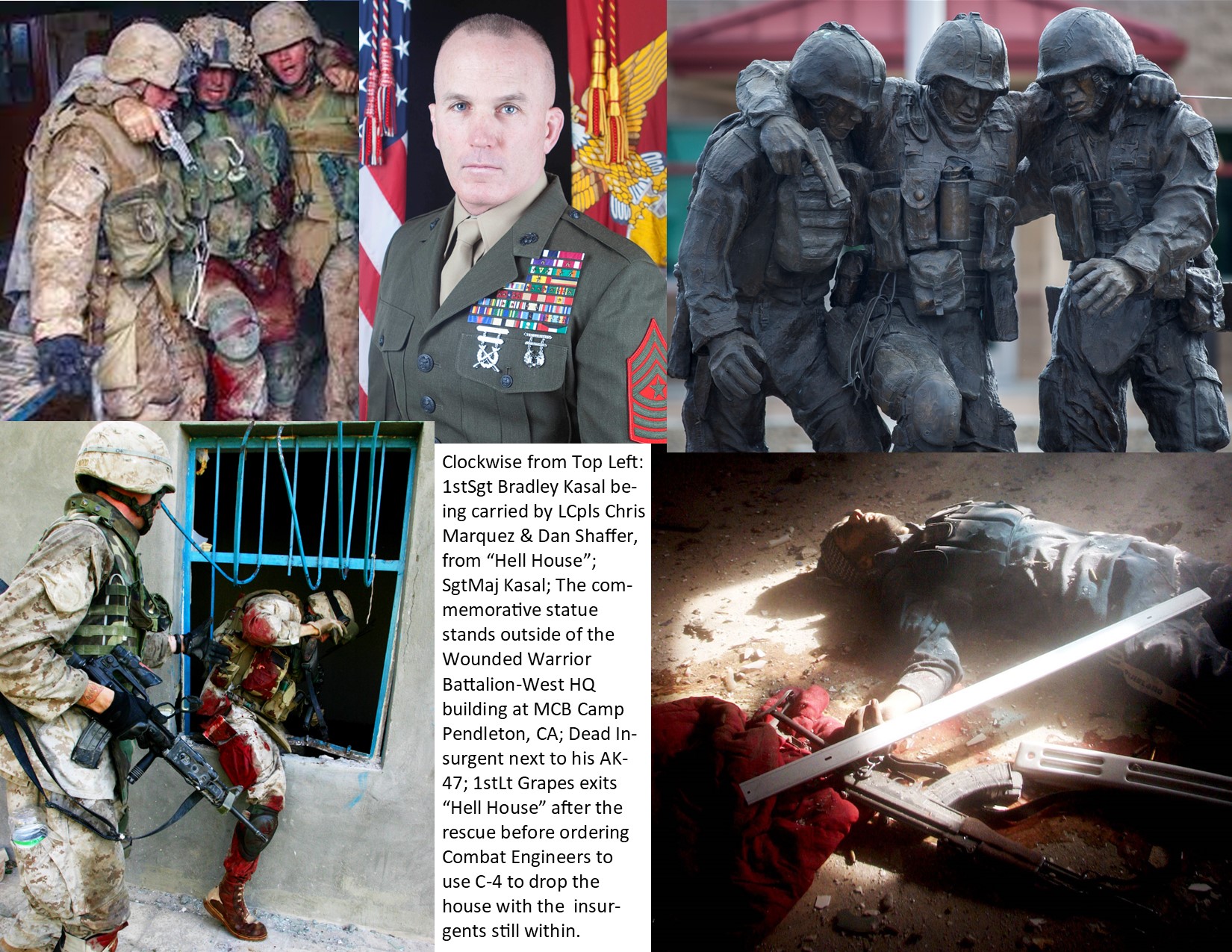
During the Second Battle of Fallujah on 13 November, a specific building became known as the "Hell House" due to the intense & brutal house-to-house fighting that took place within its walls, leaving a lasting impact on the Marines involved. The infamous building became a focal point for intense fighting, where the Marines of 3/1 faced fanatical resistance from insurgents dug in within the structure. The city's narrow streets and houses encouraged a "defense in depth" strategy, where insurgents would defend one house, then fall back & take up new positions in another, wearing down the Marines as they encountered kill zone after kill zone. The iconic image from the battle was of a bloody First Sergeant Bradley Kasal being carried out of the "Hell House" with his pistol still firmly in his hand. Even while severely wounded & surrounded by intense combat, Kasal maintained his trigger discipline, a crucial aspect of Marine training, keeping his finger off the trigger until ready to fire.
The President of the United States Takes Pleasure in Presenting The Navy Cross To Bradley A. Kasal First Sergeant, United States Marine Corps
For Services as Set Forth in the Following Citation:
For extraordinary heroism while serving as First Sergeant, Weapons Company, 3d Battalion, 1st Marine Regiment, Regimental Combat Team 1, 1st Marine Division, I Marine Expeditionary Force, U.S. Marine Corps Forces Central Command in support of Operation IRAQI FREEDOM on 13 November 2004. First Sergeant Kasal was assisting 1st Section, Combined Anti-Armor Platoon as they provided a traveling over watch for 3d Platoon when he heard a large volume of fire erupt to his immediate front, shortly followed by Marines rapidly exiting a structure. When First Sergeant Kasal learned that Marines were pinned down inside the house by an unknown number of enemy personnel, he joined a squad making entry to clear the structure and rescue the Marines inside. He made entry into the first room, immediately encountering and eliminating an enemy insurgent, as he spotted a wounded Marine in the next room. While moving towards the wounded Marine, First Sergeant Kasal and another Marine came under heavy rifle fire from an elevated enemy firing position and were both severely wounded in the legs, immobilizing them. When insurgents threw grenades in an attempt to eliminate the wounded Marines, he rolled on top of his fellow Marine and absorbed the shrapnel with his own body. When First Sergeant Kasal was offered medical attention and extraction, he refused until the other Marines were given medical attention. Although severely wounded himself, he shouted encouragement to his fellow Marines as they continued to clear the structure. By his bold leadership, wise judgment, and complete dedication to duty, First Sergeant Kasal reflected great credit upon himself and upheld the highest traditions of the Marine Corps and the United States Naval Service

The platoon commander 3rd Platoon, Kilo Co, 1stLt Jesse Grapes, had rescued his 11 wounded Marines & the body of his KIA. He then sent an explosives expert inside with a satchel charge of C4. The house erupted, the concrete mixing with the insurgents’ bodies in a pink mist as the Marines took cover nearby. After a few minutes, Grapes’ mind turned to his WIA’s gear & weapons left behind during the fighting & subsequent evacuation. He & the 3rd Platoon Marines approached the collapsed house, looking for equipment. As they peered into the rubble, an insurgent trapped underneath raised his arm & tossed a grenade. The Marines sprinted away, & after the grenade exploded, Grapes saw the man still moving. He called a ceasefire, walked onto the rubble, & unloaded half his magazine into the insurgent.
https://www.dvidshub.net/news/485168/20-years-later-remembering-second-battle-fallujah
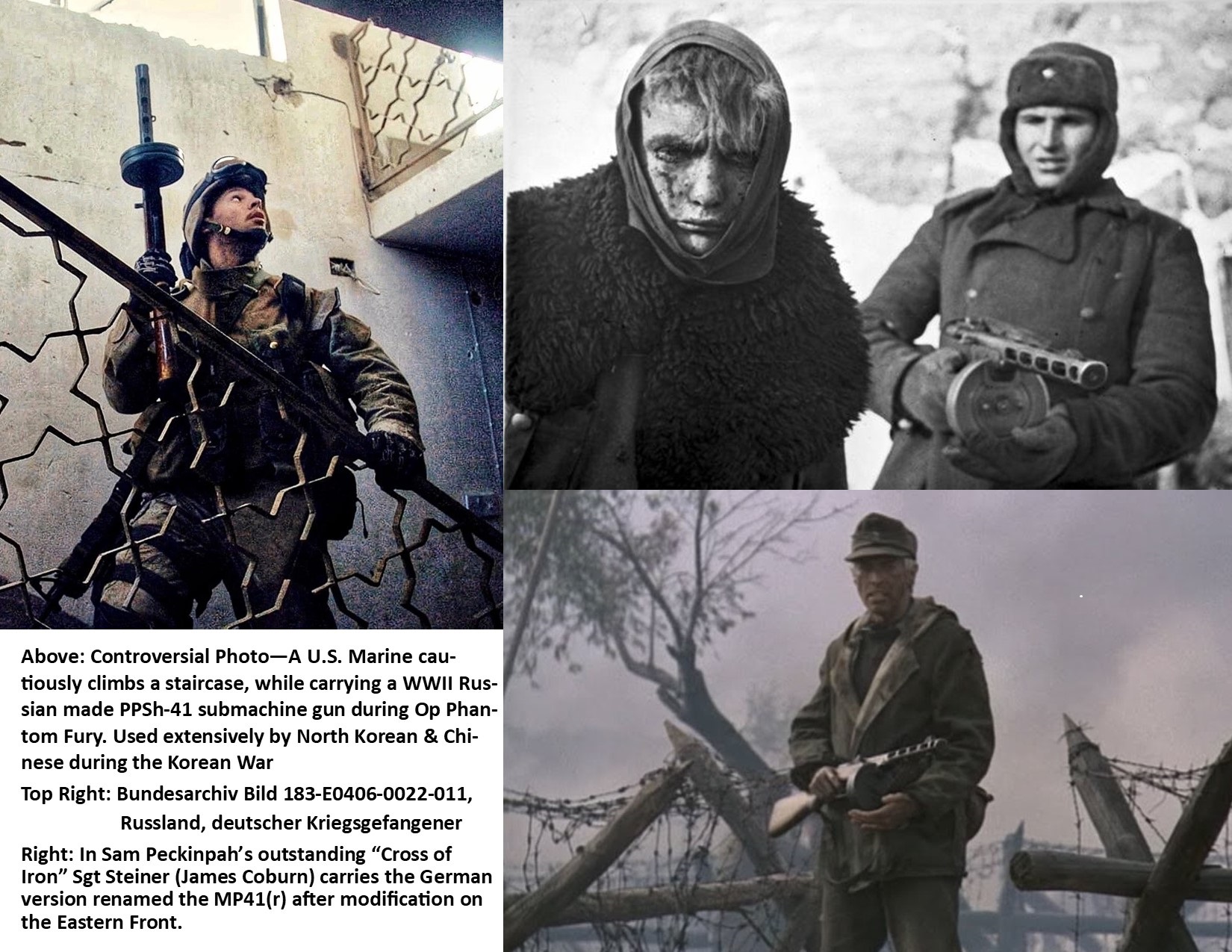
Insurgent forces were cohesive at the small unit level. They stayed & fought in the face of overwhelming U.S. firepower taking heavy casualties. They pressed home near-suicidal attacks, with little prospects for success other than inflicting a few casualties. They kept coming back for more as many insurgent positions had to be destroyed to the last man. They were tenacious, maintaining a significant level of resistance for ten days, with individuals & small groups of two or three still holding out & occasionally inflicting casualties. By "fighting to the death" they ensured greater physical destruction of the city's infrastructure from massive supporting arms used to bury them in the rubble.
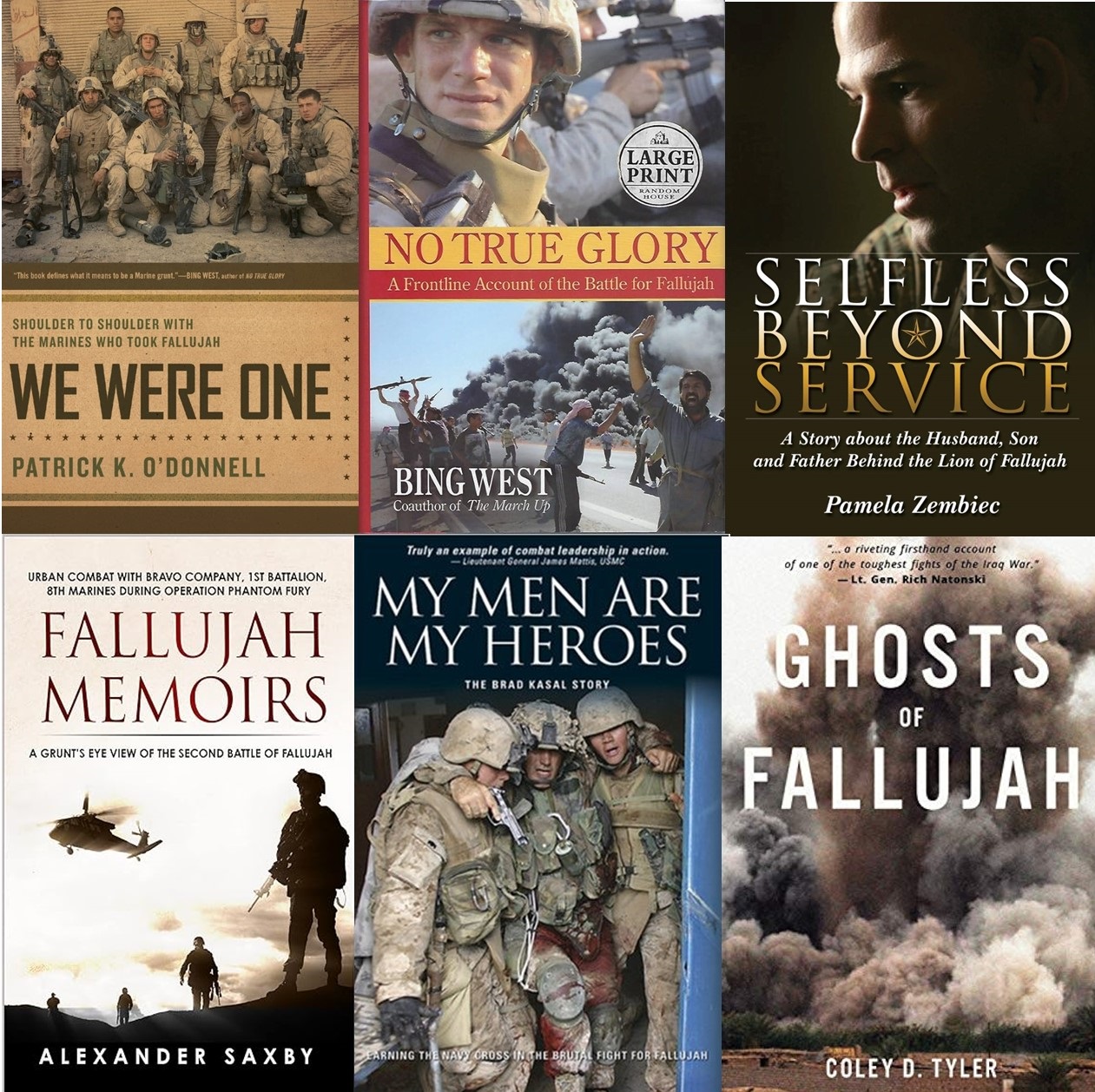
Books on The Battles of Fallujah:
1) We Were One: Shoulder to Shoulder with the Marines Who Took Fallujah by Patrick O'Donnell - 1st Platoon Lima/3rd Bn/1st Mar
2) No True Glory: A Frontline Account of the Battle for Fallujah by Bing West
3) Selfless Beyond Service: A Story about the Husband, Son and Father Behind the Lion of Fallujah by Pamela Zembiec - widow of one of the heroes of 1st Fallujah
4) Fallujah Memoirs: A Grunt's Eye View of the Second Battle of Fallujah by Alexander Saxby - A grunts eye-view with B/1/8.
5) My Men Are My Heroes: The Brad Kasal Story Hardcover by Brad Kasal & Nathaniel R. Helms – The story of Battle for “Hell House” & the Navy Cross Recipient who gives a riveting account of combat heroism
6) Ghosts of Fallujah by Coley D Tyler - A West Point graduate's account of the Second Battalion, Seventh Cavalry's participation in 2nd Fallujah
Books from History Division USMC:
1) U.S. MARINES IN IRAQ, 2004–2005 Into the Fray U.S. Marines in the Global War on Terrorism by LtCol Kenneth W. Estes USMC(Ret)
2) U.S. MARINES IN BATTLE, The Battle for Fallujah by Chief Warrant Officer 4 Timothy S. McWilliams, with Nicholas J. Schlosser
Epilogue:
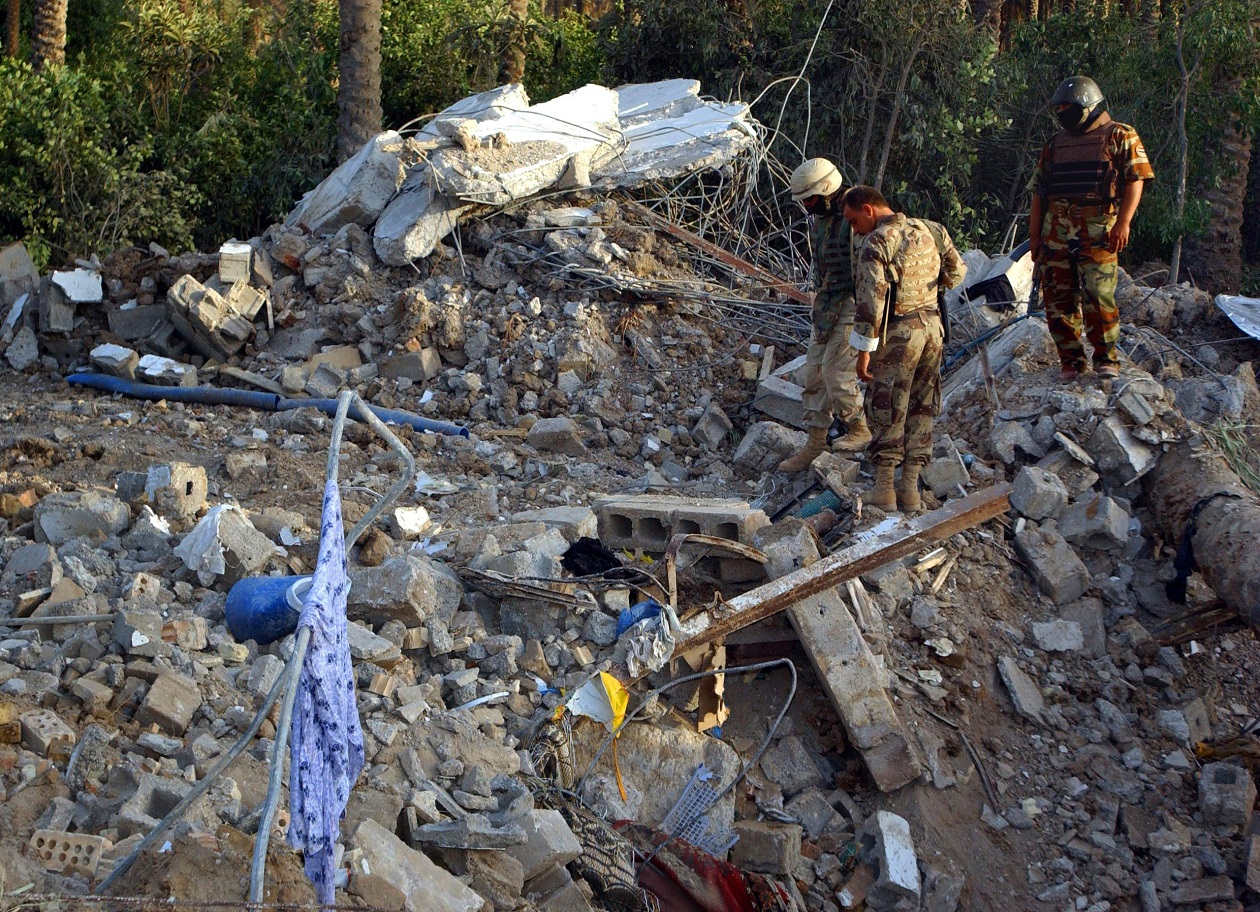
The Islamic Terrorist Zarqawi showed his “Do-As-I-Say-Not-As-I-Do” leadership by not fighting to the last man in Fallujah by slithering out of the city, but payback was a targeted air strike on 7 June 2006, while he was attending a meeting in an isolated safe house approximately 5.0 miles north of the terrorist Baqubah. Two USAF F-16C jets identified the what proved to be an unsafe house & the lead aircraft dropped two 500-pound guided bombs, a laser-guided GBU-12 & a GPS-guided GBU-38 on the building terminating all six occupants.
The Bush Administration provided another example of politicians getting the U.S. military into deadly situations, a lesson that the Biden Administration failed to learn with the Afghanistan withdrawal debacle & the senseless loss of military life at Abbey Gate. The outcome for taking Fallujah was 54 Americans killed & 425 WIAs in Op Phantom Fury action (the complete total in the city was 110 coalition KIAs & 600 WIAs in 2024.) According to a report from Gen George Casey Jr., USA Commander of all Coalition Forces in Iraq, of the 8,400 insurgents killed in 2004, 2,175 had fallen in the Second Battle of Fallujah.
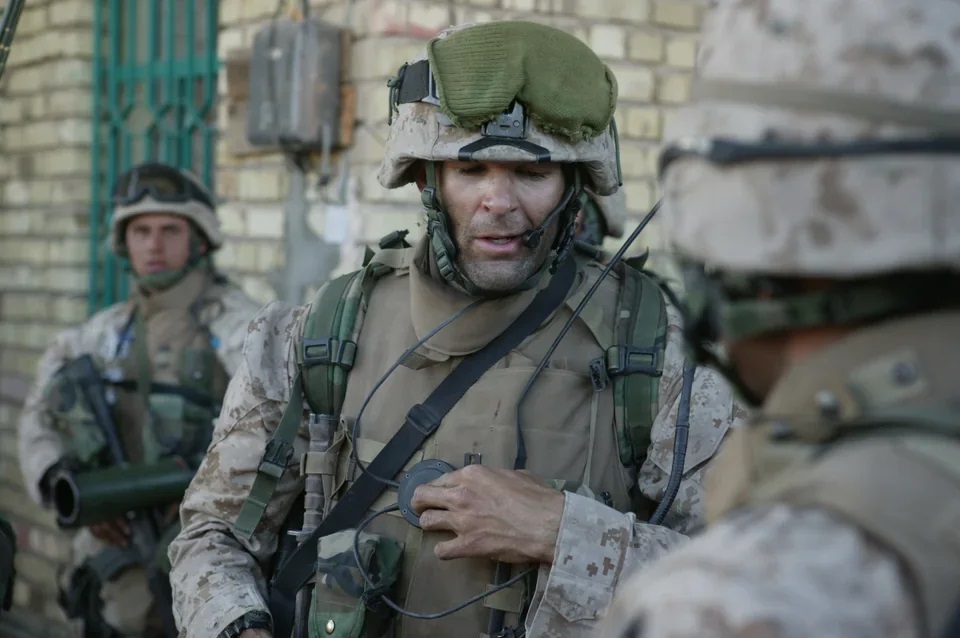
I hope the Marine Corps continues to honor those who fought in Fallujah despite no longer feeling the Battle of Iwo Jima is worth commemorating. Although the current USMC senior leadership is more concerned with DEI, I plead they remember the Corps warrior ethos represented in Captain Zembiec’s remarks to his Company the day before entering Fallujah (as related by Sergeant Major William Skiles who was at the time was Echo Company’s First Sergeant & served for 32 years.) "When the ramp drops tomorrow, who will come out? What type of human beings will come out? Will those humans honor their country, their Corps, & more important, the Marines to their left & right? When the ramps dropped from the boats on the beaches of Iwo Jima, who came out? When the ramps dropped from the helicopters in Vietnam, who came out? Honorable warriors came out to uphold the virtues & values by their actions on the battlefield. This is our time & our legacy. This is our Vietnam. This is our Okinawa. Carry the honor & traditions that formed our great nation into battle. Climb aboard, Marines!" God Bless Doug Zembiec’s memory & all the valiant lions who fought in Fallujah.
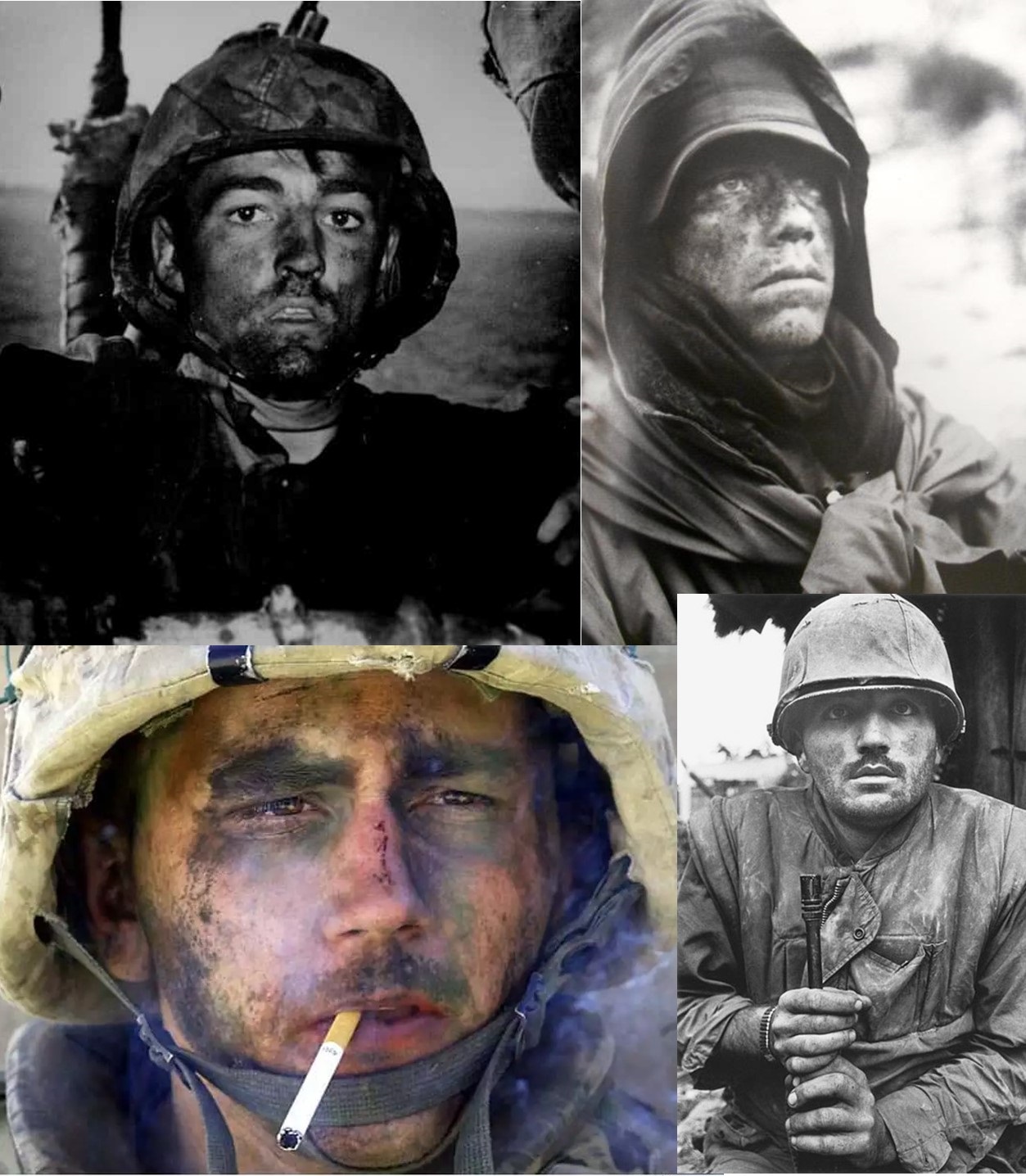
Above: The 1000-yard Stare: During WWII, Korean War, Vietnam & Fallujah!
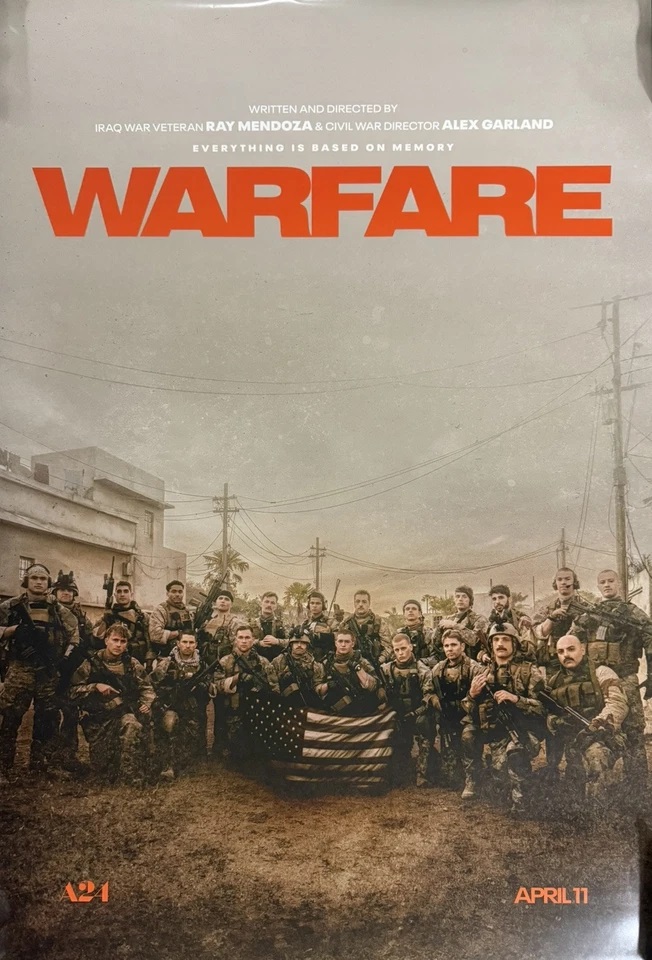
MHT is looking forward to reviewing the new movie “Warfare” which is set two years later in Iraq also in a MOUT environment as a platoon of SEALs fight their way out of a building with scenes of intense CQB.
